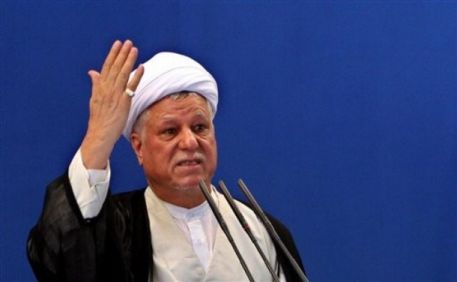Rafsanjani Makes His Move

The most important takeaway message from Ayatollah Hashemi Rafsanjani's Friday sermon in Iran today is that the regime now faces one of the most important crisis since the inception of the Islamic Republic.
This is in direct contrast to President Ahmadinejad, who has dismissed the events as marginal and minor incidents. By using the word 'crisis' in front of millions of Iranians, Rafsanjani's biggest target was Ali Khamenei. Sending a direct message to the Supreme Leader, Rafsanjani made it clear that unless a solution suitable for both sides is found, the situation will continue, and this could be dangerous.
His warning was backed up by an example about the Shah, about whom he said “it was the presence of people on the streets which broke the back of arrogant Shah's regime."
Looking for Leverage
By calling for the release of imprisoned protesters, Rafsanjani is hoping that the demonstrators will see him as their backer, and therefore, that they should continue demonstrating. This is the most critical part of his strategy, to align himself with the people on the streets and to bring out as many people as possible. This is most probably why he came close to tears when he calling for their release. Everyone knows that Rafsanjani himself does not have a good human rights record. In fact, during his own presidency he was responsible for the murder of some prominent reformists in the late 90s, in what became known as the “Chain Murders." However, the wave of arrests after the recent elections has made him look less brutal, and now he wants to use this in order to improve his bargaining position vis-a-vis Khamenei. It must be noted that this is not about regime change, but rather, about leverage to be used in a domestic balance of power politics. Rafsanjani knows very well that if the regime goes, so will his own political standing as well his multimillion dollar empire. All he is looking for is a stronger hand.
Reinforcing The Clergy
Another target audience for Rafsanjani was the clergy. "The term Islamic Republic," noted Rafsanjani, "is not a ceremonial title. It is both a republic and Islamic." Both "have to be together. If one is damaged, then we will no longer have a revolution and an Islamic Republic." Rafsanjani knows that many clergy feel left out, and the fact that Khamenei has been taking economic and political power away from them has been interpreted as an assault against the very Islamic institutions which started the revolution. The clergy also feel bitter because the revolution was not brought about by the Revolutionary Guards. They came after the clergy struggled for many years in their mosques to bring Islam into Iranian politics. They feel that Iran under Khamenei is relying less and less on its Islamic institutions, especially when it comes to making important decisions. The clergy feel that after the recent elections, decision making is based less on consensus (i.e., involving them), as Khomeini had intended for the Islamic revolution.
Conclusion
The overall goal of Rafsanjani's speech today was first and foremost to increase his own power base, and his own hand. This was done in a careful manner. Unlike Ahmadinejad, he did not accuse anyone of corruption; though he certainly could have. He tried to stick to the matter at hand, that being the demonstrations, with the hope that legitimacy can return to the current system.
Ayatollah Khamenei once said that the Islamic Republic is like a bird -- It needs two wings to fly. Khamenei and Mousavi are important part of its left-wing. Although the Supreme Leader has veered to the right recently, he should not amputate his regime's other wing. Rather, he should return to a steady course. Today, Ali Akbar Hashemi Rafsanjani offered him an opening to do precisely that.
--
Photo credit: AP Photos.



